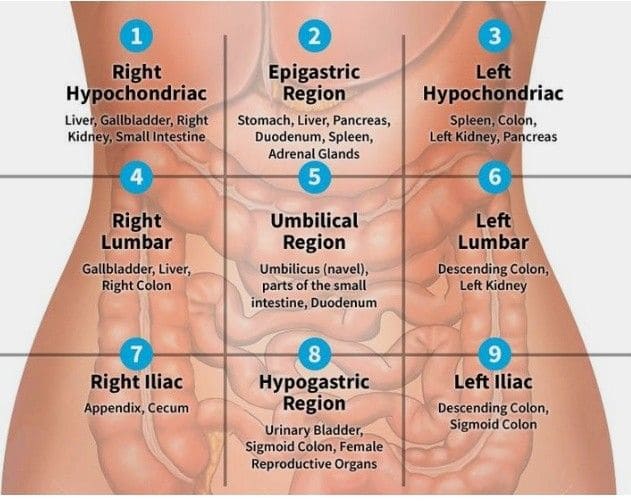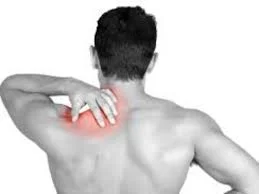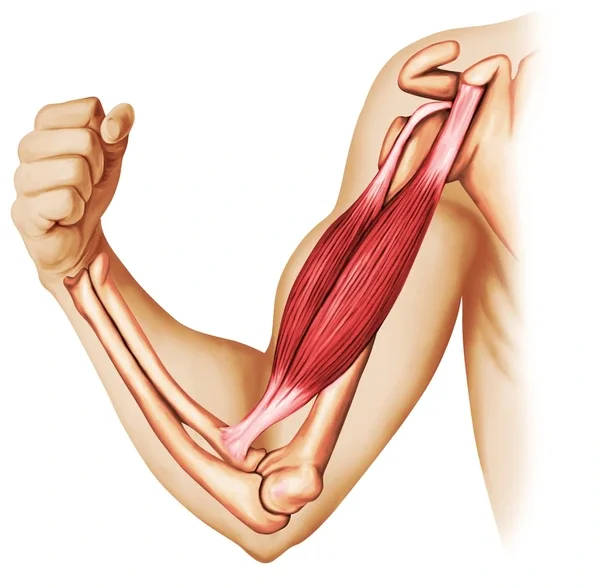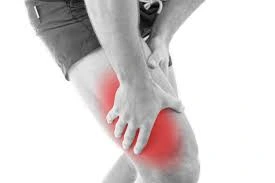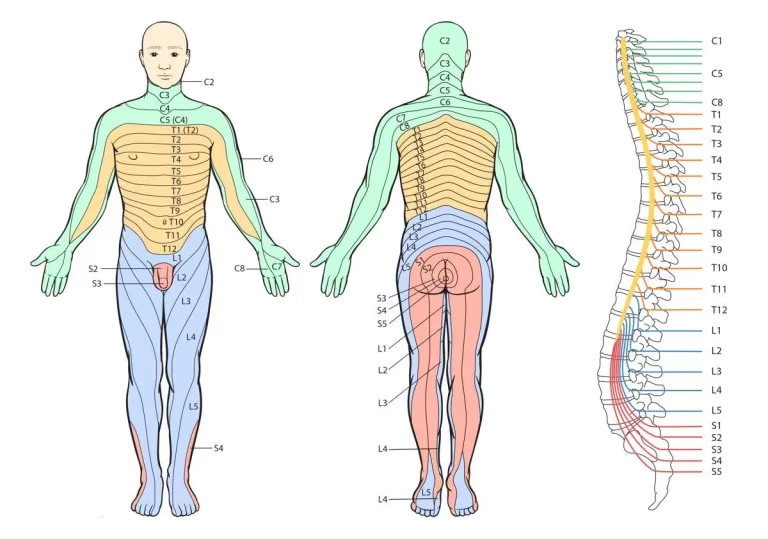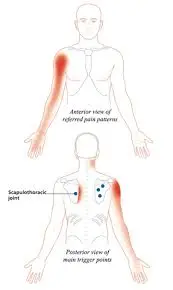Abdominal Regions
What is an Abdominal Region?
The abdominal region is anatomically divided into nine distinct areas, each serving as a reference point for identifying the location of pain, symptoms, or medical conditions. These regions are arranged in a grid pattern and are crucial in clinical assessments, diagnostic procedures, and understanding the human body’s structure.
Several crucial organs needed for digestion, excretion, and reproduction are located in the abdomen, making it an important part of the human body. In the medical sciences, knowledge of its anatomical structure and division into regions is essential for both diagnostic and therapeutic applications.
For descriptive and clinical reasons, the abdominal regions are typically separated into nine quadrants or zones. During physical examinations, medical imaging, and procedures, these divisions aid healthcare practitioners in precisely localizing and communicating findings. The distinct organs and tissues associated with each region facilitate the diagnosis of a range of diseases and disorders affecting the abdomen.
In anatomy and physiology, you will discover how to divide the abdomen into nine different regions and four different quadrants. If your goal is to work in healthcare as a nurse, you will use this on a daily basis when performing abdominal examinations (and when recording).
The region between the thorax (thoracic diaphragm) and the pelvis (pelvic brim) in vertebrates, including humans, is known as the abdomen. The abdomen can be divided into nine divisions or zones for descriptive purposes.
Anatomical regions of the Abdomen
The abdomen is composed of multiple anatomical sections, each with a unique boundary and interior. The abdominal muscles support and shield the vital organs below, helping to stabilize the spine.
The Four Abdominal Quadrants
Let us first examine the four quadrants, which are produced by the junction of the median (or midsagittal) plane and the transverse (or horizontal) plane, sometimes referred to as the transumbilical plane.
Since the left upper quadrant (LUQ), left lower quadrant (LLQ), right upper quadrant (RUQ), and right lower quadrant (RLQ) comprise the four quadrants, they are simple to recall.
It is always understood in reference to the physical position, not from your point of view, what “left or right” and “upper or lower” mean. Keep in mind that most pupils confuse their left and right areas, so take care to avoid making the same mistake.
Major Organs in the Four Quadrants
The following are some of the primary organs that are located in each of the four abdominal quadrants:
- Right upper quadrant: The right upper quadrant contains the right kidney, pancreas, liver, stomach, gallbladder, duodenum, and right adrenal gland.
- Left upper quadrant: The pancreas, left kidney, spleen, liver, and left adrenal gland are all located in this area.
- Right lower quadrant: The appendix, the reproductive organs, and the right ureter are located in this region.
- left lower quadrant: The left lower quadrant contains the reproductive organs and the left ureter.
NOTE: Each of the four quadrants contains portions of the small and large intestines.
The Nine Abdominal Regions
The intertubercular plane, also known as the inferior transverse plane, crosses the pelvic tubercles directly below the navel.
As they have the same name (differentiated by a left or right prefix) and have subsequently named the bones that are nearest to them, let’s begin by talking about the right and left columns.
Think about how memorizing common prefixes and suffixes will be very beneficial when studying anatomy, as you’ll need them again.
Hypochondriac Regions on the Left and Right: The word “hypo” means below or under. The prefix “chondritic” describes cartilage, more especially rib cartilage. When we combine the ribs, this portion of the abdomen is below them.
Left and Right Lumbar Regions: That is where this area’s name came from. Unlike the sections on the left and right side columns, these sections are named according to where they are in the stomach rather than the names of the bones. This therefore refers to the region above and above the belly.
Among the nine regions are:
- Right hypochondriac region
- Epigastric region
- Left hypochondriac region
- Right lumbar region
- Umbilical region
- Left lumbar region
- Right iliac (inguinal) region
- Hypogastric (pubic) region
- Left iliac (inguinal) region
- Converging the pelvic tubercles, the inferior transverse plane, also known as the intertubercular plane, passes slightly below the navel.
- After naming the bones that are closest to them later on, let’s begin by talking about the right and left columns, which share the same name but are distinguished by a left or right prefix. Remember, when studying anatomy, knowing the common prefixes and suffixes will come in very handy.
- Hypochondriac Regions (Left and Right): The terms “Hippo” and “below” refer to the left and right hypochondriac regions. Underneath the ribs when we combine them is this region of the abdomen. There are hypochondriac areas on your left and right, yes.
- Lumbar Regions (Left and Right): Lumbar refers to the vertebrae in your lower back that are closest to the lumbar region.
- Left and Right Iliac Region: We have now completed the columns on the left and the right.
- Epigastric Region: The words “gastric” and “epi” denote the stomach or belly, respectively, and above or over.
- Umbilical Region: The umbilicus, another name for your navel, is easily remembered because it is situated in the umbilical region.
- Hypogastric Region: The definitions of hypo and gastric, as is already known, are “below” and “belly,” respectively.
- If you are looking for a quick memory trick to help you remember the names of these sections, just remember that the side columns have the same titles from top to bottom: iliac, lumbar, and hypochondriac (HLI). The umbilical, hypogastric, and epigastric regions are those in the middle column (EUH). Remember this fashion statement: Hector loves Isabel unconditionally.
Organs in the Nine Abdominal Regions
Although most instructors of basic anatomy don’t require you to know every organ’s location based on memory, they do expect you to have a general understanding of where each organ is located.
- Right Hypochondriac Region: Gallbladder, liver, right kidney, and sections of the small and large intestines
- Epigastric Region: This area of the body, which also comprises a portion of the liver, contains the stomach, pancreas, duodenum, spleen, and adrenal glands.
- Left Hypochondriac Region: The stomach, big or small intestines, liver tip, pancreas, and spleen are located in this area of the left hypochondriac.
- Right Lumbar Region: The right kidney, part of the small intestine, and the ascending colon are located in this region.
- Umbilical Region: small intestine, duodenum, and transverse colon.
- Left Lumbar Region: left kidney, small intestine, and descending colon.
- Right Iliac Region: appendix, cecum.
- Right Iliac Region: The reproductive organs, small intestine, bladder, and a portion of the sigmoid colon are located in the hypogastric region.
- Left Iliac Region: small intestine, descending colon.
Differential Diagnosis
Children
- gastroenteritis
- mesenteric adenitis
- Meckel’s diverticulitis
- intussusception
- Henoch–Schönlein purpura
- Lobar pneumonia
Adults
- regional enteritis
- renal colic
- perforated peptic ulcer
- testicular torsion
- rectus sheath hematoma
- pelvic inflammatory disease
- ectopic pregnancy
- endometriosis
- torsion/rupture of ovarian cyst
- appendicitis
Elderly
- diverticulitis
- intestinal obstruction
- colonic carcinoma
- mesenteric ischemia
- leaking aortic aneurysm
Clinical Significance
Abdominal divisions are crucial to many facets of medical practice, including:
- Methods for physical examinations: Physicians utilize the abdominal regions as reference points for auscultation, percussion, and palpation during physical examinations.
- Diagnostic imaging and interpretation: Radiologists and clinicians usually refer to abdominal areas when discussing and interpreting results from imaging modalities such as computed tomography (CT), magnetic resonance imaging (MRI), and ultrasound.
- Surgical techniques and considerations: Surgeons use the abdominal regions to plan incisions, expose specific organs, and perform procedures such as laparoscopy and laparotomy.
- Differential diagnosis of abdominal diseases: The localization of physical findings and symptoms within specific abdominal regions facilitates differential diagnosis and narrows the range of probable diagnoses for abdominal disorders.
- If the lower left quadrant is the site of peritonitis or abdominal pain, then possible diagnoses are pelvic inflammatory disease, diverticulitis, colitis, ureteral colic, or stomach pain from ovarian cysts. Cancers like colon and ovarian cancer can affect the left lower quadrant.
- Intestinal malrotation may cause the LUQ to feel uncomfortable or sore. The RLQ, particularly the right iliac fossa and inguinal area, can become sensitive and painful in conditions such as appendicitis.
- Its presence is important because it can signal acute hemorrhagic pancreatitis, abdominal injury, or even metastatic malignancy.
Conclusion
Healthcare personnel involved in the diagnosis and treatment of abdominal disorders need to have a thorough understanding of the abdominal areas. Clinicians can improve the quality of patient care, increase the accuracy of their diagnoses, and improve surgical results by being familiar with the anatomical divisions and clinical relevance of abdominal regions.
FAQs
What region is the Iliac in?
The Regions of the Iliac Abdomen
Of the nine abdominal areas, these are two. The inferior areas of the abdomen on the left and right are home to the iliac regions.
What’s the point, McBurney?
A McBurney point is a location that is one-third of the way laterally on a line that connects the right anterior superior iliac spine to the umbilicus. It is in line with the traditional position of the appendix’s base.
What lies in the area of the hypogastrium?
situated between the inguinal regions and directly beneath the umbilical region. bladder, rectum, small intestine, sigmoid colon, and the left and right ureters. Uterine tubes, left and right ovaries, and uterus in females. Males: prostate, seminal vesicles, and ductus deferens.
Which abdominal organ is known as the policeman?
This is because of the way omental tissue functions immunologically; it appears to “surveil” the abdomen for infections and, when they are discovered, wall off the areas of infection with tissue that is immunologically active.
Which nine regions make up the abdominal region?
The right and left hypochondriac regions, the epigastric region, the umbilical region, the right and left lateral areas of the abdomen, the hypogastric region, and the right and left inguinal regions are the nine regions that make up the abdomen according to these planes.
Where may one find a hypochondriac?
The two superolateral abdominal regions that are located on either side of the epigastric region are known as the hypochondriac regions.
What area does the appendix reside in?
The appendix is a tiny, finger-shaped tube that emerges from the large intestine’s first segment. An infection or inflammation of the appendix may result in lower right abdominal pain.
Where in the body is the liver?
The liver is situated above the stomach, right kidney, and intestines in the upper right section of the abdominal cavity, under the diaphragm.
What lies within the area of the stomach?
The epigastrium is the area of the belly where the Heimlich technique, or abdominal thrusts, can cause a powerful and quick evacuation of breath. It is possible to feel the structures beneath the epigastrium by palpating it. This covers the stomach and liver.
Which are the main abdominal organs?
Summary. The stomach, small intestine (jejunum and ileum), large intestine (colon), liver, spleen, gallbladder, pancreas, uterus, fallopian tubes, ovaries, kidneys, ureters, bladder, and numerous blood vessels (arteries and veins) are among the many essential organs located in the abdomen.
Which body part is known as the abdomen?
The body’s largest cavity is the belly or abdomen. It houses many of the body’s organs and is located between the chest and the pelvis.
What is the total number of abdominal regions?
Every vertical line intersects the midpoint of the symphysis pubis and the anterior superior iliac spine.
What is the purpose of the abdominal region?
Structure and Function
In the end, the abdomen acts as a cavity to hold essential reproductive, circulatory, endocrine, exocrine, and digestive system organs.
Which organs are located in the abdominal quadrants?
The following are some of the principal organs located in each of the four abdominal quadrants: The pancreas, right kidney, stomach, gallbladder, duodenum, liver, and right adrenal gland are all located in the right upper quadrant.
How many abdominal areas are there?
Envision the abdominal cavity segmented into these nine areas.
What is the abdomen’s anatomy?
The Abdomen of Humans The Abdominal Anatomy. The area of the human body between the chest and the waist is called the abdomen. Numerous organs in the human body, including the liver, gallbladder, stomach, spleen, pancreas, kidneys, adrenal glands, and bowels, are housed in this cavity.
References
- Serasiya, A. (2022, October 14). Abdominal regions. Samarpan Physiotherapy Clinic. https://samarpanphysioclinic.com/abdominal-regions/
- Physiotherapist, N. P. (2024b, March 9). Abdominal Regions – Mobile Physiotherapy Clinic. Mobile Physiotherapy Clinic. https://mobilephysiotherapyclinic.in/abdominal-regions/

